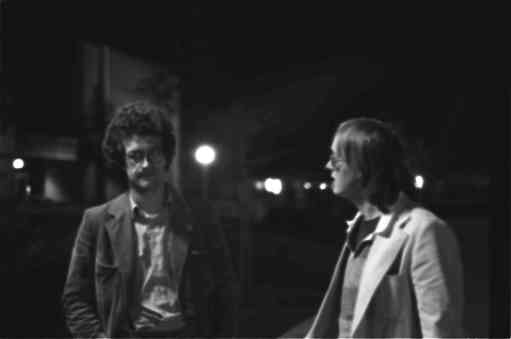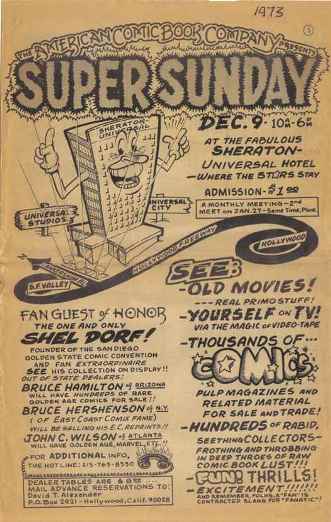The following article is about the July 30th through August 3rd, 1975 San Diego Comic-Con and first appeared on August 22, 1975 in the Los Angeles Free Press (where the author was Book Editor). It is presented here by permission of the author.
by David Laurence Wilson
August 22, 1975
Thursday, 8 p.m.: It’s not The Incredible Hulk, Captain America, or Nick Fury, but another newly minted legend. Jim Steranko, Marvel Comics artist during the late sixties, after five years of self-imposed exile says, “I’m an artist for the people. I believe in mass art.”
Later, there’s beer around the El Cortez pool for two dozen comic fans — 21 men, three women. Comics are a male sport. There are more comics per square foot than anywhere else in the country; it’s the largest audience for correspondence school advertising in the world. Two extra security guards are at the El Cortez Hotel for the convention; one spends his night reading Spider Man in the Dealer’s Room, the other chases the last drinkers from the pool at 12:30. Yellow Submarine is in the Caribbean Room; there’s a party in room 503.
The San Diego Comic Convention, from July 30 to Aug 3, was in its fifth year as the second largest convention for mass art enthusiasts in the country, and it’s starting to crowd the New York Convention. San Diego brought out Ray Bradbury, the underground comics and several of the hiding superstars: Steranko, Jack Kirby, Will Eisner and Jerry Siegel.
Though dominated by the Marvel Company, the convention was a meeting of contrasts — the East Coast and the West Coast; the undergrounds and the overgrounds; the older craftsmen and the younger, more activist artists; the hero worshippers and the hungry doodlers — and usually the distinctions are blurred.
“This is an Insult!”
An early theme of the convention contained a large measure of scorn for the New York companies. Panelists took cheap shots at “comics written for a 12-year-old mind” and “Why does everyone have to be a barbarian?”. There were a lot of complaints about the number of advertising pages in each of the Marvel products. Jack Katz, an intense Berkeley artist who started drawing comics for $5 a day at 16, has received quite a few accolades for the first two installments on a 24-issue, 12-year project, The First Kingdom. He served as the token anarchist on several of the panels.
His own lecture started out with a pair of slides from his days with Detective Comics. First, a slide of his original artwork, then the final product, before he shouted, “This is an insult! Where are the slippers, the flowers in the original? These companies strangle the artists and the artists’ minds. They’re not interested in creativity. They’ll say, ‘Hey, you’re a pretty good artist. Let’s see you do a Spiderman!’ They’re resurrecting corpses — the whole country involved with necrophilia. The companies have destroyed some of the finest talents in the world.”
While almost half of the 2,000 fans were hanging out in the Dealer’s Room, several comic writers were hunting up typewriters in a last-ditch attempt to make their deadlines. Organizers repeatedly called for attention in the downstairs mix of buying and trading to browbeat the customers into attending the panels and lectures.
In the Dealer’s Room, a first issue of Conan was the measure of trade: about five Conans for a #1 Avengers, 10 to a #1 Spiderman, or 15 to a #1 Fantastic Four. Shel Dorf, the convention’s MC, pushed Katz’s First Kingdom series upstairs, “You just know this is going to be more valuable than Conan …” And an autograph added about 10 percent to the value of any item.
The market for original artwork, in particular, is getting bigger every year, so many of the artists, dealers and artists’ agents appeared well prepared. The convention was filled out with The Cartoonists Banquet and Brunch With The Celebrities. An 8 x 10 photo with one of the stars was available for $5, or five photos for only $20.
While the book artists came prepared with their self-conscious limited-edition portfolios and posters, the newspaper serial artist were refreshing in their unassuming attitudes. Dick Moores, from the Gasoline Alley strip, served as the patriarch of a panel that included Sergio Aragones from MAD and Broom Hilda’s Russell Meyers. Frank Ridgeway, from the Mr. Abernathy strip, snuck up to MC Dorf to scratch a chalk mustache under his nose after he’d set up Dorf for a caricature.
Aragones filled up one side of his manila folder with his doodles before he started to sign autographs. Later, Jack Kirby, the king of comic art, called his Captain America character a plug for patriotism.
The relationship between artist and superhero is almost Egyptian: the comic artist is the closest thing to the hero incarnate. Under pressure, Jack Kirby admitted, “In a sense, I am Captain America.” Another real life superhero incarnate, the rotund Captain Sticky, appeared with blue suit and cape, brocade, beard and crash helmet, handing out his privately printed comics while he talked about elective office.
One conventioneer, a rocket designer from Arizona on a separate vacation from his wife, heard a noise outside his window and peeked outside. Frank Brunner, Jim Starlin and Howard Chaykin, three of the Marvel Company’s best young artists, were out talking on the roof. Chaykin looked towards the rocket designer, “Well, I guess we’re bothering the real people.”
A Day For Applause
Before Friday, the best of the convention had been Steranko’s remarks on Thursday night. Friday was a day for applause. First, Kirby and Steranko’s look at Captain America ended with a standing ovation for the modest Kirby. Next up was magician Patrick Culliton for a discussion and demonstration of Houdini and his magic, then Chuck Norris appeared on stage for a karate demonstration. The audience was up and applauding for everything from the escape tricks to Norris’s explanation of Bruce Lee’s death.
The Masquerade Show slowly moved towards chaos. Local DJ Gabriel Wisdom dressed as Marvel’s Thor, swinging his mirrored hammer between assorted vampires and space creatures. One space vampire, a middle-aged woman, asked her son how she’d done, then lit up when he said the men in the back were whistling. The KGB radio station’s Chicken took the “Best of the Show” award.
Raoul Duke appeared with his All-Human Orchestra. Despite an electric guitar system that failed halfway through a “Pinball Wizard”-derived tribute to Forrest J. Ackerman, the band made it through “Reprint Wizard” and “The Monster Mash”. Then a barely explained troupe of girls from a San Diego dance studio were up on the stage and kicking.
Star-filled Weekend
The weekend was star-filled, though National Comics, the big #2 company, was only represented by its ex-employee Jerry Siegel, the creator of Superman, the man who started all the superhero stuff, who tried to remain anonymous, begging at least one sharp-eyed fan not to let on he was there. Daws “Huckleberry Hound”, “Quick-
Draw McGraw”, “Super Snooper” Butler did his around-the-world voice routine after a discussion on animation. George Pal’s presentation was overwhelmed by the publicity surrounding his new Doc Savage release. Will Eisner, of The Spirit, was convinced he’d bored everyone with his Spirit slide show, and George Clayton Johnson bored no one with his introduction to Ray Bradbury.
A few fans, also, stood out from their fellows: a silent, simian longhair who was constantly twirling his battery-powered yo-yo, and a pair of girls with Spiderman tattoos. Younger fans came complete with their best attempts at drawing their superheroes, and the Star Trek Trekkies were matched by another group that had taken Gilligan’s Island to heart.
Inside Info
The comic fan left the convention with an earful of information. It’s a bad time for a new writer or artist to try to break into the market. The Atlas Comics Company has called it quits, and the rest of the companies have cut back in their titles. Marvel has eliminated most of its black and white comic magazines and cut The Man Wolf, The Living Mummy and Man-Thing color comics.
Jack Kirby is back with Marvel, where he’s already working on several projects, including an adaptation of 2001. Another Marvel character, “Howard the Duck”, will have his own magazine. “Felch”, a new underground, is the “dirtiest comic imaginable”, starting “a new cycle of filth”, proving “You can still turn a buck by being dirty.”
The biggest news is an upcoming battle between Marvel’s Spiderman and National’s Superman, a company crossing first. If it succeeds monetarily, there’s bound to be more of the crossovers, though the rival companies are already filing anti-trust suits.

Author David Wilson (right) and German film director Wim Wenders from the mid-seventies
David Laurence Wilson is a San Diego native whose consistent journey north has left him in the California Gold Country, where he’s found a house big enough for a wife, two kids and lots of books and comics. David grew up in the ‘fifties. Comic books were always a treat – so were Sunday comics sections. In 1961 his mother reluctantly allowed him to buy a Mad annual and Fantastic Four #1 at the drugstore beside Bullock’s Wilshire. A life-changing experience indeed!
Wilson began attending the San Diego convention during the early ‘seventies while attending college in Orange County. During the nineteen eighties he began exhibiting designs from his rubber stamp company, Ready-Made Rubber, featuring the talents of Rick Geary, Moebius, Bob Crabb, Dan Piraro, Roger Langridge, Geof Darrow, J. R. Williams, Eric Bowman and others.
Wilson has written for many newspapers and magazines, even contributing a handful of gags for the “Bizarro” comic panel. Most recently Wilson has contributed biographical introductions for the Stark House Press “Noir Classics” series, contributing essays on the crime fiction masters Harry Whittington, Gil Brewer and W. R. Burnett. He wrote about the San Diego writing scene in his essays on Wade Miller and A. S. Fleischman.
Since 1985 Wilson has missed the San Diego convention twice: first when he was above the Arctic Circle in Norway’s Lofoten Islands, site of Edgar Allan Poe’s “Descent Into the Malestrom”, and second, for cancer surgery.
Wilson says: Let’s hear it for early detection, folks. No one is going to die because their cancer was diagnosed too early! Health care should be a right in civilized societies.
